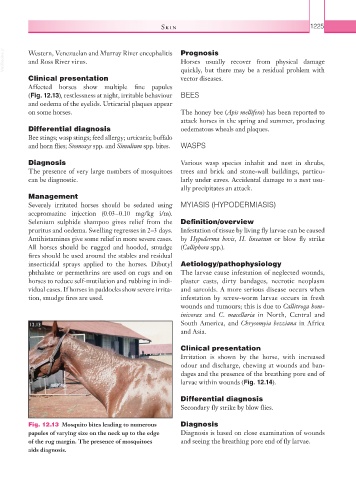Page 1250 - Equine Clinical Medicine, Surgery and Reproduction, 2nd Edition
P. 1250
Skin 1225
VetBooks.ir Western, Venezuelan and Murray River encephalitis Prognosis
Horses usually recover from physical damage
and Ross River virus.
Clinical presentation quickly, but there may be a residual problem with
vector diseases.
Affected horses show multiple fine papules
(Fig. 12.13), restlessness at night, irritable behaviour BEES
and oedema of the eyelids. Urticarial plaques appear
on some horses. The honey bee (Apis mellifera) has been reported to
attack horses in the spring and summer, producing
Differential diagnosis oedematous wheals and plaques.
Bee stings; wasp stings; feed allergy; urticaria; buffalo
and horn flies; Stomoxys spp. and Simulium spp. bites. WASPS
Diagnosis Various wasp species inhabit and nest in shrubs,
The presence of very large numbers of mosquitoes trees and brick and stone-wall buildings, particu-
can be diagnostic. larly under eaves. Accidental damage to a nest usu-
ally precipitates an attack.
Management
Severely irritated horses should be sedated using MYIASIS (HYPODERMIASIS)
acepromazine injection (0.03–0.10 mg/kg i/m).
Selenium sulphide shampoo gives relief from the Definition/overview
pruritus and oedema. Swelling regresses in 2–3 days. Infestation of tissue by living fly larvae can be caused
Antihistamines give some relief in more severe cases. by Hypoderma bovis, H. lineatum or blow fly strike
All horses should be rugged and hooded, smudge (Calliphora spp.).
fires should be used around the stables and residual
insecticidal sprays applied to the horses. Dibutyl Aetiology/pathophysiology
phthalate or permethrins are used on rugs and on The larvae cause infestation of neglected wounds,
horses to reduce self- mutilation and rubbing in indi- plaster casts, dirty bandages, necrotic neoplasm
vidual cases. If horses in paddocks show severe irrita- and sarcoids. A more serious disease occurs when
tion, smudge fires are used. infestation by screw-worm larvae occurs in fresh
wounds and tumours; this is due to Callitroga hom-
inivorax and C. macellaria in North, Central and
12.13 South America, and Chrysomyia bezziana in Africa
and Asia.
Clinical presentation
Irritation is shown by the horse, with increased
odour and discharge, chewing at wounds and ban-
dages and the presence of the breathing pore end of
larvae within wounds (Fig. 12.14).
Differential diagnosis
Secondary fly strike by blow flies.
Fig. 12.13 Mosquito bites leading to numerous Diagnosis
papules of varying size on the neck up to the edge Diagnosis is based on close examination of wounds
of the rug margin. The presence of mosquitoes and seeing the breathing pore end of fly larvae.
aids diagnosis.

